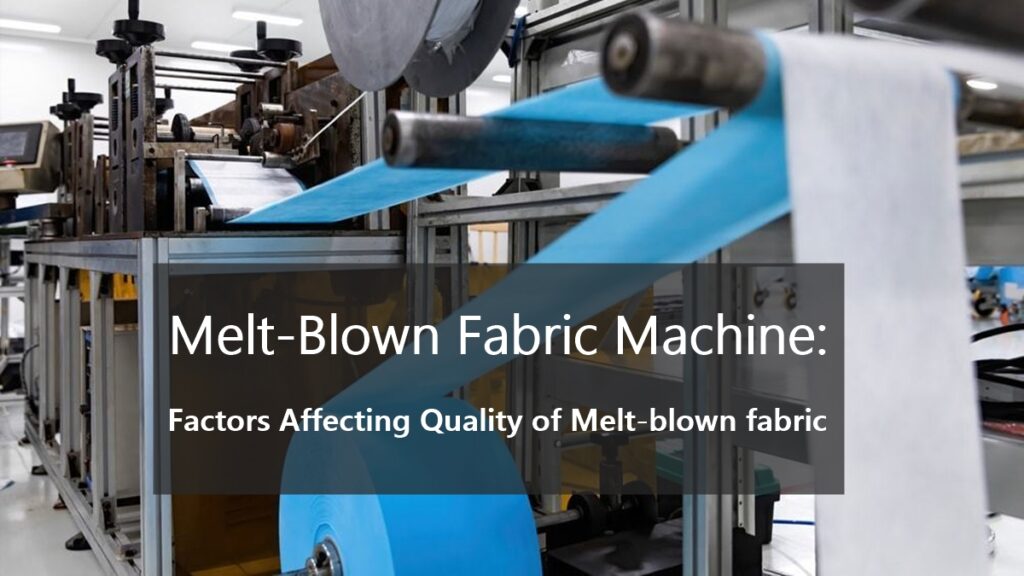In recent times, the COVID-19 outbreak has caused deep wounds in all national societies and economics. With no certainties about the official release of an antivirus vaccine, we will still be relying on surgical masks as the primary way of prevention. Even though producing medical masks is not an overly complicated procedure, to obtain high-quality products, different aspects still need to be considered. Raw materials and top machinery play a crucial role in satisfying the increasingly demanding international regulations.
Employing a melt-blown fabric machine is the most efficient and productive way to realize melt-blown fabric. In this brief article, we will talk about melt-blown fabric and melt-blown cloth equipment. Specifically, we will look at the main factors affecting the quality of the melt-blown fabric.
Melt Blown Fabric Process Overview
A melt-blown fabric is a non-woven fabric with polypropylene (PP) as its primary raw material. Melt-blown cloth is produced utilizing melt-blown fabric manufacturing machines. Melt-blown fabric machines are generally composed of a screw extruder, filters, a metering pump, a heating system, a net forming apparatus, and a winding device.
Melt-blown non-woven fabric is created by extrusion of the melted polymer through a particular “blown spinning” technology. The spinning procedure uses high-speed hot airflow to stretch, solidify, and reshape the melted polymer quickly. Ultimately, the fiber is projected onto the collection support (a cylinder or other suitable surfaces). This action creates a finely tangled microfiber tape (collected in rolls), that will be converted into finished product.
The benefit of this method is that it is fast, cost-saving, and makes higher quality cloth. Because of the fiber diameter of a melt-blown fabric being just 1 to 5 microns, it has better fold resistance. The melt-blown fabric machine produces ultra-fine fibers with special capillary structures with better filtering, shielding, and heat insulation properties. Thus, the melt-blown fabric is the most effective solution to absorb and block viruses and germs.
Factors influencing the quality of Melt-Blown Fabric
The first aspect to consider is the quality of the raw materials. As mentioned above, the melt-blown fabric is the finest material for making surgical masks. The internal structure of the cloth is composed of many crossed microfibers stacked in undefined patterns. An important indicator to consider is the MFI of the polypropylene. The MFI is the measurement of the index of the ease of flow of a thermoplastic polymer. This value is important because the finer the wire is drawn over the melting process, the better is the cloth’s filtration efficiency.
The second aspect and an equally important element is the performance of the melt-blown fabric machine. If you want to rest assured, you need to search for reliable suppliers. Here, we have reported some of the factors that can undermine the final product quality, as a result of inferior equipment:
Screw extrusion velocity
Melt-blown fabric machine screw extrusion rate should always be kept within the parameters. The faster the extrusion speed, the greater the quantitative of melt-blown cloth. However, if the measurement is exceeded, the strength of the melt-blown fabric decreases.
Hot Air Jet Angle and Velocity
The hot air jet angle directly affects the drawing effect and fiber microstructure. Smaller angles will lead to the formation of parallel fiber bundles, making the non-woven fabric inconsistent. The ideal angle should be 90° (or above). In this way, the material will be properly distributed.
On the other hand, hot air speed affects fiber entanglement. Faster hot air speed will result in smaller fiber diameter, better entanglement, and more density for an increased strength capability in the fabric.
The Receive Distance (DCD)
Receive distance is another factor to be kept other control. Disproportionate distance in the producing process can cause the lowering of horizontal and vertical bending strength. As a result, the end product would have less filtration efficiency and resistance, consequently diminishing the overall quality.
All of these problems can be prevent by finding high-performance melt-blown fabric machines. Recently launched on the market, we have seen the joint effort in the development of DEKUMA and its partner Hongwei. The new small and medium-sized machines have comprehensive advantages over the mainframe standard equipment.
Dekuma solution has optimal ventilation and electrostatic absorption performance. The German ingenious design concept provides high running stability and fully complies with international environmental standards. Ultimately, medium-sized melt-blown fabric machines are easier to operate and upkeep, they are overall the smarter investment compared to large equipment.
Conclusion
For over 15 years, Dekuma has been internationally known as the leading provider of rubber and plastic processing technologies. The company’s team is devoted to continuous research and development of a new melt-blown fabric machine providing international partners with total solutions on a turn-key basis.
If you are interested in knowing more about the melt-blown fabric production machine, DEKUMA professional experience is at your disposal.

